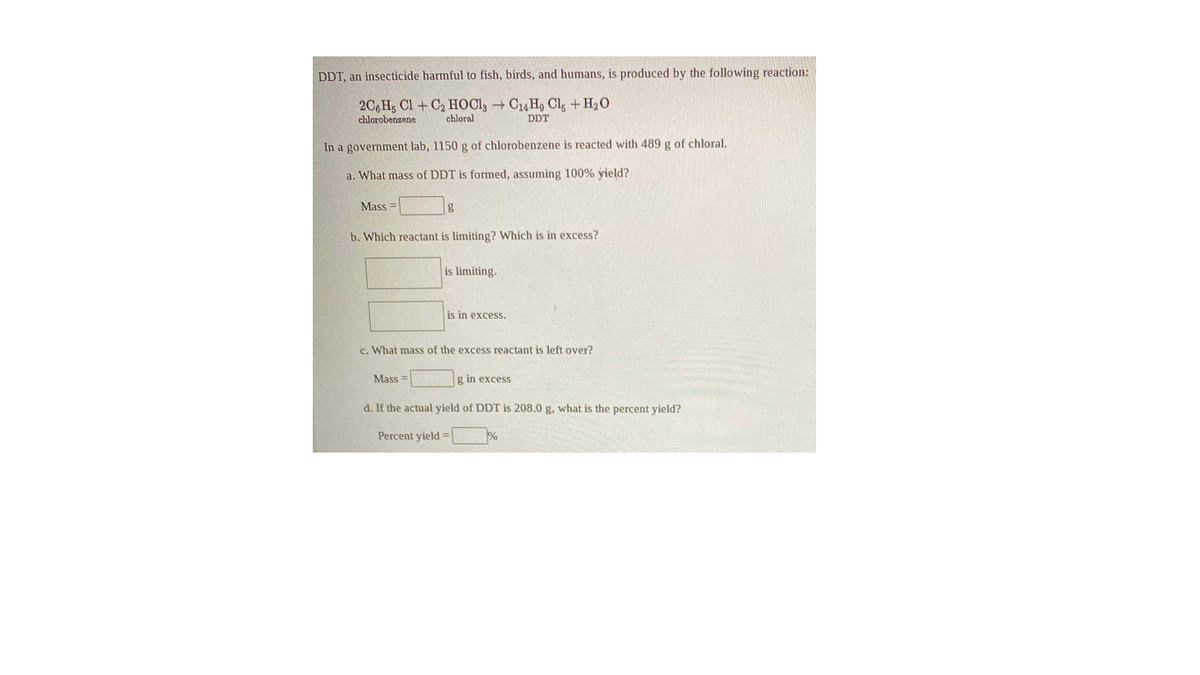DDT, an insecticide harmful to fish, birds, and humans, is produced by the following reaction: 2C Hg Cl + C2 HOCI, C14H, Cl, + H20 chlorobensene chloral DDT In a government lab, 1150 g of chlorobenzene is reacted with 489 g of chloral. a. What mass of DDT is formed, assuming 100% yield? Mass = b. Which reactant is limiting? Which is in excess? is limiting. is in excess. c. What mass of the excess reactant is left over? Mass = g in excess d. If the actual yield of DDT is 208.0 g, what is the percent yield? Percent yield =
DDT, an insecticide harmful to fish, birds, and humans, is produced by the following reaction: 2C Hg Cl + C2 HOCI, C14H, Cl, + H20 chlorobensene chloral DDT In a government lab, 1150 g of chlorobenzene is reacted with 489 g of chloral. a. What mass of DDT is formed, assuming 100% yield? Mass = b. Which reactant is limiting? Which is in excess? is limiting. is in excess. c. What mass of the excess reactant is left over? Mass = g in excess d. If the actual yield of DDT is 208.0 g, what is the percent yield? Percent yield =
Chapter3: Stoichiometry
Section: Chapter Questions
Problem 172CP: The aspirin substitute, acetaminophen (C8H9O2N), is produced by the following three-step synthesis:...
Related questions
Question
Question attached

Transcribed Image Text:DDT, an insecticide harmful to fish, birds, and humans, is produced by the following reaction:
2C Hg Cl + C2 HOCI, C14H, Cl, + H20
chlorobensene
chloral
DDT
In a government lab, 1150 g of chlorobenzene is reacted with 489 g of chloral.
a. What mass of DDT is formed, assuming 100% yield?
Mass =
b. Which reactant is limiting? Which is in excess?
is limiting.
is in excess.
c. What mass of the excess reactant is left over?
Mass =
g in excess
d. If the actual yield of DDT is 208.0 g, what is the percent yield?
Percent yield =
Expert Solution
This question has been solved!
Explore an expertly crafted, step-by-step solution for a thorough understanding of key concepts.
This is a popular solution!
Trending now
This is a popular solution!
Step by step
Solved in 4 steps

Knowledge Booster
Learn more about
Need a deep-dive on the concept behind this application? Look no further. Learn more about this topic, chemistry and related others by exploring similar questions and additional content below.Recommended textbooks for you


Chemistry
Chemistry
ISBN:
9781305957404
Author:
Steven S. Zumdahl, Susan A. Zumdahl, Donald J. DeCoste
Publisher:
Cengage Learning

Chemistry: The Molecular Science
Chemistry
ISBN:
9781285199047
Author:
John W. Moore, Conrad L. Stanitski
Publisher:
Cengage Learning


Chemistry
Chemistry
ISBN:
9781305957404
Author:
Steven S. Zumdahl, Susan A. Zumdahl, Donald J. DeCoste
Publisher:
Cengage Learning

Chemistry: The Molecular Science
Chemistry
ISBN:
9781285199047
Author:
John W. Moore, Conrad L. Stanitski
Publisher:
Cengage Learning

Chemistry: An Atoms First Approach
Chemistry
ISBN:
9781305079243
Author:
Steven S. Zumdahl, Susan A. Zumdahl
Publisher:
Cengage Learning

World of Chemistry, 3rd edition
Chemistry
ISBN:
9781133109655
Author:
Steven S. Zumdahl, Susan L. Zumdahl, Donald J. DeCoste
Publisher:
Brooks / Cole / Cengage Learning

Chemistry for Engineering Students
Chemistry
ISBN:
9781337398909
Author:
Lawrence S. Brown, Tom Holme
Publisher:
Cengage Learning